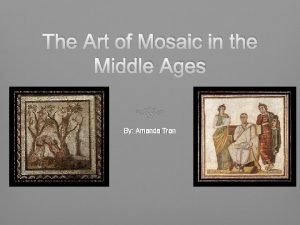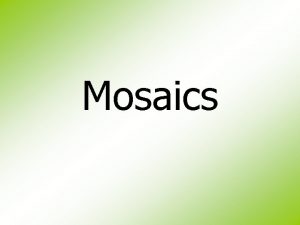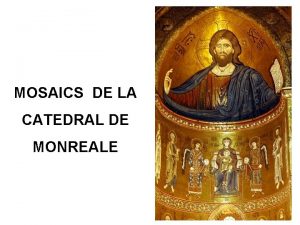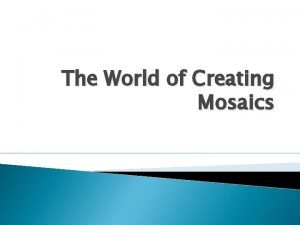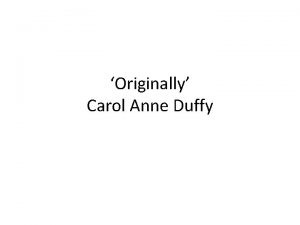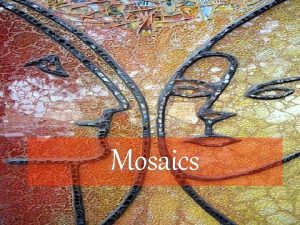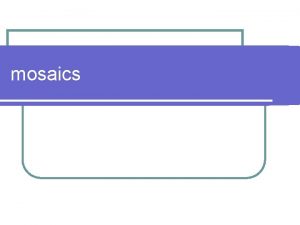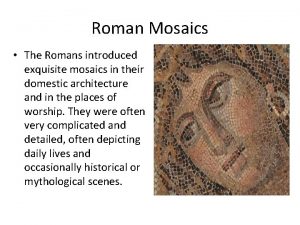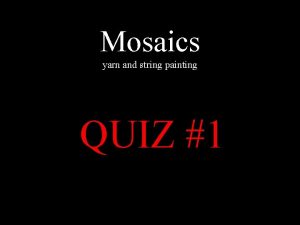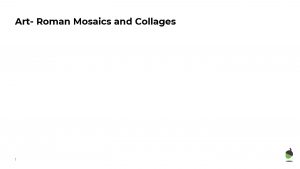Mosaics Originally the art of making mosaics came










- Slides: 10

Mosaics

• Originally the art of making mosaics came to Italy from Greece • Early mosaics were made out of simple black and white tesserae • Tesserae = small pieces of stone • Later mosaics became more complex with multicoloured tesserae (polychrome: now stone, marble or glass) being used to produce scenes replicating paintings with all their intricate shading and highlighting • The technique used to make these mosaics was called opus vermiculatum • Roman mosaic artists rarely signed their work • Mosaics had both practical and aesthetic purposes - Pebbled roads vs. Floor coverings • Mosaics were found in both public and private places • Most mosaics would have been commissioned • Popular themes in mosaics were of mythological nature and everyday life • It was vey popular to match the mosaic with the room - e. g. Dionysus in the dining room • Were made as a decoration, show of wealth or for propaganda purposes • Specialised artists would have been employed to make the mosaic



Emblemata • Prefabricated mosaic that would have been constructed in a workshop and set in a panel • The emblema would be worked on by a master craftsman specialising in mosaics • The emblemata would then be set in a pre-prepared spot in the floor. Often they were the centrepieces of a larger floor, the surrounding floor being paved in opus sectile or opus tessellatum. • They were easily transportable which meant they did not have to be made in Pompeii, but could come from as far away as Greece. • Being moveable also meant they could be taken from house to house • Singular = emblema • Plural= Emblemata A MOSAIC MADE ON SITE AND FOR A PARTICULAR SPACE IS CALLED ‘IN SITU’

An example of Emblemata

Opus Vermiculatum • This technique was used for polychrome (colour) mosaics • The tesserae were very small, often from 1 -4 mm, and irregular in shape • the tesserae were stone, glass or marble • The rows of tesserae wind like worms • Vermiculus means “little worm” It enables a number of techniques: ü Outlines ü The light coloured tesserae show highlighting üDark coloured tesserae show shading üLines provide shape and movement üShow a change in tone and conveys a sense of volume

An example of Opus Vermiculatum

Opus Sectile • This technique was often used for pavements • Harder materials could be used, like slate and limestone

Monochrome Mosaics • These mosaics consisted of tesserae of just black and white stone. • They were particularly common because of the fact that they were much cheaper to produce
 Dark ages mosaic
Dark ages mosaic History of mosaics
History of mosaics Catedral de monreale planta
Catedral de monreale planta Universal unity mosaics
Universal unity mosaics Irony in the rime of the ancient mariner
Irony in the rime of the ancient mariner Making inferences
Making inferences War making and state making as organized crime
War making and state making as organized crime What was the game of volleyball originally called?
What was the game of volleyball originally called? Unix was originally developed in
Unix was originally developed in The presence of coal in antarctica indicates that
The presence of coal in antarctica indicates that Carol ann duffy originally
Carol ann duffy originally
